The Ultimate Guide to The Best Tools for Your Home Workshop
RYOBI GENERAL
10/15/202515 min read
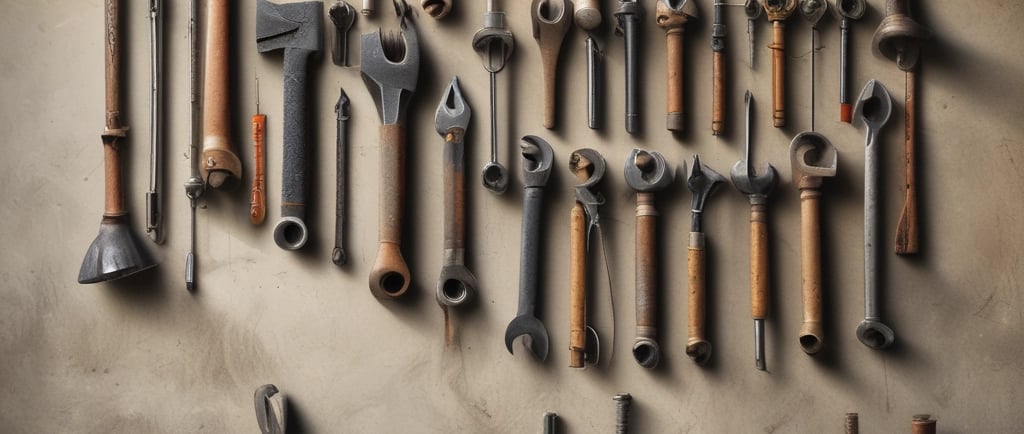

Introduction to Ryobi Tools
Ryobi is a well-respected brand in the power tools industry, renowned for its commitment to quality, innovation, and affordability. Established in Japan in 1943, Ryobi has evolved into a global leader, providing a comprehensive range of tools that cater to both DIY enthusiasts and professionals. The brand has carved a niche for itself in the home workshop segment, where its name is synonymous with reliability and performance.
The vast selection of Ryobi power tools includes everything from drills and saws to sanders and impact wrenches, all designed with the user in mind. Each tool is built to withstand the rigors of various projects, ensuring they maintain their effectiveness over time. Moreover, Ryobi's garden equipment offers solutions for maintaining pristine outdoor spaces, further broadening the brand’s appeal. The consistency in quality and innovative features makes Ryobi tools an excellent investment for those looking to enhance their home workshops.
What sets Ryobi apart is its focus on creating user-friendly products. Many tools are designed with ergonomic handles and lightweight materials, providing ease of use and comfort during operation. Furthermore, the brand’s commitment to advancing technology is evident in its introduction of battery-operated tools that ensure portability without sacrificing power. Whether you are a weekend warrior or a seasoned craftsman, Ryobi’s array of tools promises functionality while offering value for money.
This presentation of Ryobi tools not only establishes the brand as a go-to choice for home workshops, but it also highlights the essential attributes that resonate with users—durability, performance, and affordability. As we delve deeper into the specific tools Ryobi offers, it becomes clear why it remains a preferred name in the tool industry.
Top Power Tools for Your Workshop
Disclosure: This post contains affiliate links. If you click and make a purchase, I may earn a small commission at no extra cost to you.
RYOBI ONE+ 18V Cordless 1/2 in. Drill
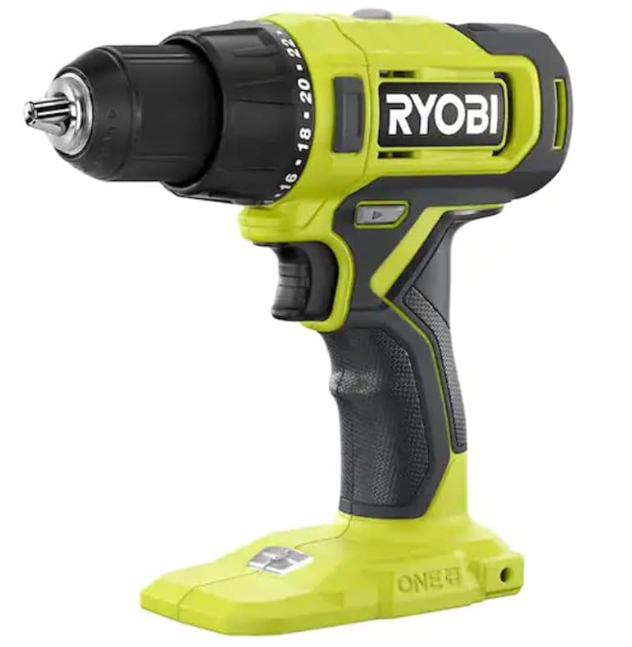

Click 'Shop Now!' to find on Amazon now...
🛠️ Specification
The RYOBI ONE+ 18V ½‑inch Drill/Driver is part of the ONE+ battery system, meaning it shares batteries and chargers with other tools in the RYOBI ecosystem. It typically includes a ½‑inch keyless chuck for quick bit changes. The drill offers two speed ranges: a slower mode for higher torque, and a faster mode for drilling tasks. No‑load speeds often range up to about 1,500–2,000 RPM in high gear (depending on the variant). It also features a multi‑position clutch (often around 24 settings) plus a drill mode beyond those clutch settings, allowing control when driving screws in varying materials. The tool includes an LED work light to brighten sockets, inside cabinets, or dark corners. Ergonomically, it is designed to be compact and balanced, with a rubberized grip for better handling and reduced fatigue. As a cordless tool, the weight includes whatever battery is installed, so total weight varies depending on battery capacity (e.g. 2.0 Ah, 4.0 Ah, etc.).
✅ Advantages and Disadvantages
Advantages:
Battery commonality: If you own or plan to build a collection of RYOBI ONE+ tools, this drill fits seamlessly into that ecosystem, reducing extra battery/charger expense.
Versatility: The two speed settings and multi-clutch make it flexible—good for both drilling holes and driving screws of different sizes and materials.
Compact and user-friendly: The ergonomic design and manageable size are well suited to home workshops, especially where space is limited or you need to work overhead or in tight spots.
LED illumination: Helps when working in shelves, cabinets, or low-light areas; less need for extern lighting sources.
Affordability: Generally, RYOBI tools are priced competitively, making this a cost-effective option for DIYers and home workshops.
Disadvantages:
Torque limitations: It’s not a heavy-duty drill—very large fasteners, deep holes in hardwood, or sustained heavy use may push it to its limits.
Battery weight + performance trade-off: With a higher-Ah battery installed, the drill becomes heavier; with a lower-Ah battery, performance or runtime might be compromised.
Plastic parts wear: Some components (chuck housing, gear selector parts) may be plastic and thus may degrade or loosen with heavy use over time.
Lack of premium features: Compared to high-end professional drills, it may lack features like brushless efficiency (in older models), advanced electronics, or ultra-precise control.
LED brightness: Useful but limited—may not fully compensate in very low ambient light situations, so additional lighting may still be needed.
🔍 Our Review
In our home workshop use, the RYOBI ONE+ 18V ½‑inch Drill/Driver has proven itself to be a dependable workhorse for general woodworking, furniture assembly, shelf installation, and many common tasks. It handles pilot drilling, screw driving, and light material boring with ease. The clutch allows good control, which is especially helpful when driving screws close to edges or into thinner plywood.
The drill feels comfortable in the hand—even with a mid-capacity battery—and balance is reasonable for normal usage. The LED does a helpful job of illuminating darker spots, which improves workflow in cabinets or during late-night tinkering sessions. For hobbyist work, it strikes a balance between affordability and performance.
One weakness is in tougher jobs like driving lag bolts into dense hardwood; in those cases, performance slows and battery drain is noticeable. Also, when the battery is larger, the added weight begins to show in longer sessions or overhead. For precision joinery or ultra-fine drilling, I sometimes switch to a smaller, more refined drill for delicate tasks. But as an all-around tool for a home workshop, the RYOBI delivers solid value and reliable performance.
🗣️ Other Customers’ Reviews
Many users appreciate this drill for being a solid, value-friendly option. Common praise centers on how well it fits into the ONE+ system—those with existing RYOBI batteries often note it's one of the first tools they pick up. Customers often comment that it handles everyday tasks—drilling, driving screws, occasional metal tasks—with confidence and without issue.
Critical feedback tends to focus on its limits—some users mention that when pushing it hard (large screws, dense wood), it slows or stalls, and sometimes feels underpowered compared to more premium models. A few report that after extended use, the chuck or housing parts feel less tight, especially in lower-cost versions. The LED is often cited as helpful but not a replacement for proper workshop lighting.
Overall, the RYOBI ONE+ 18V ½‑inch Drill is viewed by many as a dependable, affordable, and versatile option that is well suited for home workshops and general DIY use. If you already have the ONE+ battery ecosystem, many users say it’s a no-brainer addition to your toolkit.
18V ONE+ 7-1/4" Miter Saw
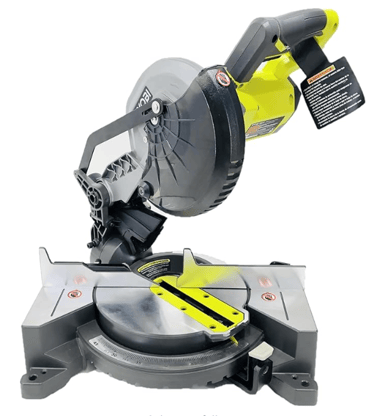

Click 'Shop Now!' to find on Amazon now...
🛠️ Specification
The RYOBI 18V ONE+ 7-1/4" Miter Saw is a compact, cordless miter saw that runs on the RYOBI ONE+ 18V battery system. It features a 7-1/4-inch blade and is capable of cutting through wood, trim, and small boards. The saw offers miter cuts from 0° to 45° left and bevel cuts from 0° to 45°, making it suitable for angled and compound cuts. It has a no-load speed of up to 4,500 RPM, providing smooth and fast cuts for most light- to medium-duty applications.
The cutting capacity typically includes crosscutting materials up to 2x4 inches at 90° and 2x3 inches at 45°. It includes a laser alignment system to help guide accurate cuts and comes with a dust collection bag or port to help manage sawdust. The tool is lightweight—generally under 20 pounds—which makes it easy to move around a home workshop or jobsite.
✅ Advantages and Disadvantages
Advantages:
Portability: The cordless design and lightweight body make it easy to move around a home shop or even take outdoors for on-site projects.
Battery compatibility: Works with all RYOBI ONE+ 18V batteries, making it convenient for users already in the ecosystem.
Decent power for size: 4,500 RPM is more than enough for most home tasks like cutting trim, molding, baseboards, and 2x4s.
Compact design: Perfect for small workshops with limited bench space.
Laser guide: Assists with straight, clean cuts and improves user confidence.
Ease of use: Simple setup and intuitive operation make it beginner-friendly for home DIYers.
Disadvantages:
Limited cutting capacity: Not ideal for cutting larger boards or hardwoods; the 7-1/4” blade can’t handle thick stock like a 10” or 12” saw would.
Battery drain under load: Heavier or repeated cuts can drain batteries quickly, especially with older or low-capacity packs.
Bevel range limited: Only single-bevel (not dual), which can limit flexibility on certain compound cuts.
Plastic components: Some parts (like the base and fence) are plastic rather than metal, which could impact long-term durability under heavy use.
Not a professional-grade tool: Suited more for DIY, not for large-scale or contractor-level work.
🔍 Our Review
In our home workshop, the RYOBI 18V ONE+ Miter Saw has become one of the most-used tools for small projects. Whether cutting quarter-round for trim, chopping up 2x2 stock for shelves, or trimming up reclaimed wood for DIY furniture, this saw has the precision and portability we need.
Its cordless nature makes it incredibly convenient—no need to find an outlet or wrestle with extension cords. Setup is fast, and the laser guide does a good job of keeping cuts accurate. The saw handles 2x4s reasonably well, though it slows slightly on denser material. It's not meant for big crown molding or deck framing, but for typical home workshop projects, it's more than capable.
We especially appreciate how easy it is to store and carry. When the bench is full, we can move it to a work table or the floor without much effort. Runtime is decent with a 4.0Ah battery, and blade changes are straightforward. Overall, it's an ideal saw for anyone doing light construction, home improvement, or woodworking as a hobby.
🗣️ Other Customers’ Review
Home users and DIYers largely praise the RYOBI 18V 7-1/4” Miter Saw for its portability, simplicity, and effectiveness in small workshops. Many say it's a perfect first miter saw—easy to use, accurate enough for basic trim work, and powerful enough to handle most home tasks.
Common compliments include the laser guide (which helps boost confidence for newer users), the quick setup, and how it fits into tight spaces. It’s also appreciated by those who don’t have a dedicated shop, as it's easy to store and carry around.
On the downside, some users report that the battery life shortens when cutting dense or wet lumber, and others wish it had more cutting capacity or dual-bevel capabilities. A few noted that while the plastic base keeps it light, it doesn’t feel as stable as larger, more expensive models.
Despite that, most reviews from hobbyists and weekend warriors are positive—especially for those already invested in the RYOBI ecosystem.
RYOBI - ONE+ HP 18V Brushless Cordless 4-Mode ½ in. Impact Wrench
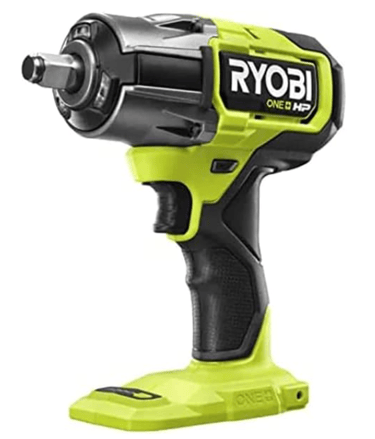

Click 'Shop Now!' to find on Amazon now...
🛠️ Specification
The RYOBI ONE+ HP 18V Brushless ½‑inch Impact Wrench is a cordless muscle tool in the ONE+ battery ecosystem. It features a brushless motor for higher efficiency, better runtime, and less maintenance. The “4‑mode” designation means it offers four operational modes (often including varied torque or speed settings and maybe a fastening vs. loosening mode) to tailor performance for different tasks (delicate vs heavy fasteners).
The output torque is substantial for its class — typically enough to drive large lag bolts or loosening stubborn nuts in home and workshop use. The tool includes a ½‑inch square drive anvil (likely with a detent pin or hog ring) for standard sockets and attachments. It also uses RYOBI’s electronic controls to protect against overload, overheat, and overdischarge, safeguarding both tool and battery.
In terms of ergonomics, the tool is designed to be balanced and hand-friendly, with a grippy handle and an LED work light to illuminate fasteners in dim locations. The total weight (tool + battery) is moderate, making it suitable for repeated use in a home shop environment. Because it's part of the ONE+ system, it works with all existing RYOBI 18V batteries and chargers.
✅ Advantages and Disadvantages
Advantages:
Strong torque output: Suitable for a wide range of fastening and loosening tasks in a shop — driving lag screws, bolts, tightening structural connectors, and more.
Four modes of operation: Gives you flexibility, letting you dial back power for more sensitive tasks (to avoid stripping screws or damaging soft wood) or ramp up for tougher fasteners.
Brushless motor efficiency: Better battery life, less heat, and more durability compared to brushed motors — helpful when used frequently in a home workshop.
Interoperability with ONE+ system: If you already own RYOBI ONE+ batteries, the impact wrench slots right into your existing toolkit without needing new chargers or packs.
LED light: Helps when working in low-light corners, under benches, behind cabinets, or even in garages at night.
Compact and balanced design: Easier to maneuver in tight spots or when reaching into jig spaces, compared to bulkier impact wrenches.
Disadvantages:
Battery dependency: High torque modes drain battery more rapidly, especially under continuous load, so you’ll want at least one spare pack.
Weight with battery: Though balanced, once a battery is attached it becomes heavier, which can fatigue your wrist or hand in extended use.
Overkill for small jobs: On delicate or light fasteners (small screws, trim mounting), the tool may be too aggressive—even in low mode—leading to overdriving or damage.
Noisy and percussive action: As with all impact wrenches, it’s loud and produces vibrations, so for long sessions or finish work this can be fatiguing or less refined.
Learning curve: The multiple modes require familiarity; using the wrong mode or speed can lead to mistakes or damage, especially if you're not accustomed to impact tools.
🔍 Our Review
In our home workshop setting, we found the RYOBI ONE+ HP ½‑inch Impact Wrench to be a super useful tool that bridges the gap between traditional drills and heavier impact drivers. It tackles lag bolts, carport fasteners, structural connectors, and heavy screw jobs with authority — tasks that a drill would struggle with or that would overheat if done repeatedly.
The mode settings are genuinely helpful. For example, we used a lower mode for fastening cabinet hardware to avoid stripping screws in plywood, and switched to higher modes when securing outdoor brackets or heavy timber. The brushless motor stays cooler even on repetitive work, and the battery life is acceptable with a 4Ah or 5Ah pack, though not unlimited.
The LED light is a surprisingly useful addition; we often work in corners or under shelves where lighting is poor, and the built-in illumination helps reduce mistakes. The tool is comfortable to hold, and the distribution of weight is well engineered so it doesn’t feel clumsy in hand.
However, it’s not perfect. In very tight corners or when overhead, the battery’s heft becomes more noticeable. If we pushed it to extreme torque modes for extended intervals, battery depletion became evident, so having spare batteries is essential. Also, the impact action is aggressive — for smaller hardware or delicate wood, I’d still switch to a regular driver or use the lowest mode carefully.
Overall, it’s an excellent addition to a home workshop lineup, especially for those who already use RYOBI ONE+ and want one tool to tackle heavier fastening tasks.
🗣️ Other Customers’ Review
Many users praise the impact wrench for its capability and value within the RYOBI ONE+ system. Users often mention being able to remove rusty bolts, drive large exterior fasteners, and handle demanding tasks without needing corded or bulky impact wrenches. The four-mode versatility is commonly highlighted — people like the ability to dial it back for lighter, more precise jobs.
On the downside, customer feedback often echoes the battery/weight trade-offs: heavier battery packs reduce maneuverability, and high torque use drains batteries faster. Some state that when using it on small or delicate screws, the tool can be too strong even in low mode, leading to mistakes. A few mention that vibration and noise can become fatiguing over prolonged sessions, especially without gloves or anti-vibration gear.
RYOBI ONE+ 18V Cordless Reciprocating Saw
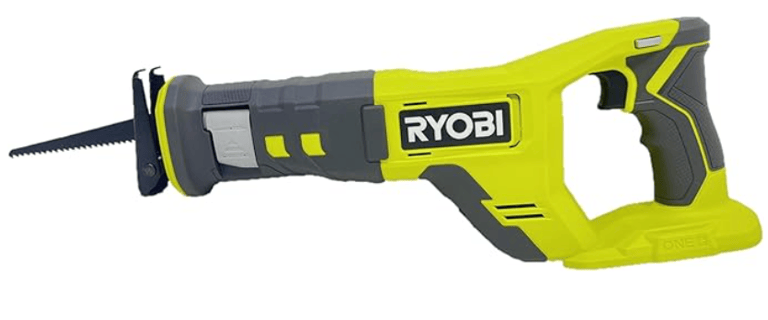

Click 'Shop Now!' to find on Amazon now...
🛠️ Specification
The RYOBI ONE+ 18V Reciprocating Saw is part of the ONE+ battery system, meaning it shares batteries and chargers with many other RYOBI tools. It features a brushless or brushed motor (depending on variant) that can deliver up to approximately 3,000 strokes per minute (SPM). It has a stroke length of roughly 1‑1/8 inch, which provides a decent balance of cutting speed and control.
The saw includes tool‑free blade change, so switching blades (wood, metal, demolition) is quick and straightforward. There’s an adjustable shoe (foot) that lets you set how much blade exposure you want, improving control and minimizing vibration. Variable speed trigger gives you control over how aggressively the blade cuts. The body is designed for a comfortable grip, often with rubber overmolding, and the tool is relatively compact and balanced for one‑handed use. The saw works with standard reciprocating saw blades and fits in the ONE+ ecosystem with shared batteries.
✅ Advantages and Disadvantages
Advantages:
Flexibility: As a reciprocating saw, it handles demolition, rough cuts, trimming, pruning, and cutting through nails or embedded objects, making it useful for mixed workshop tasks.
Cordless convenience: Without a cord, you can move freely around your workshop or job site without needing to reposition power cords — especially helpful in small workshops.
Tool-free blade changes: Speed of swapping blades makes it easier to switch between cutting wood, metal, or rough demolition tasks.
Adjustable shoe: Helps stabilize the blade, reduce vibration, and control cut depth or blade deflection — improving accuracy in tighter cuts.
Variable speed trigger: Let’s you ease into cuts or back off when approaching sensitive material, giving more control.
Compact and manageable weight: Designed to be hand‑friendly, so it doesn’t fatigue you too quickly during typical home shop jobs.
Disadvantages:
Not ultra‑precise: Reciprocating saws are inherently rough; for fine woodworking, straight cuts or delicate finishes, you’ll usually need a different tool (e.g. track saw, circular saw).
Battery drain under heavy use: Long cuts or heavy loads will deplete battery faster, especially with smaller Ah packs.
Vibration and noise: It’s inherently vibratory and noisy — over long periods that can tire your hand or hearing without protection.
Blade selection matters heavily: Using low‑quality or wrong blades will yield poor cuts, faster wear, more vibration, and worse results.
Dust and debris management: Because it throws material aggressively, without dust control the shop can get messy and fine dust can get airborne.
🔍 Our Review
In our home workshop, the RYOBI ONE+ 18V Reciprocating Saw has become one of the more frequently used tools for cleanup, rough cuts, trimming, and demolition prep. It excels when we need to cut old framing, remove trim, cut embedded nails, or make rough cuts in scrap wood.
The cordless nature is a big benefit — we don’t worry about extension cords getting in the way or limiting reach. We often use it around workbenches, cutting down materials in place. The adjustable shoe helps when working off edges or near walls to reduce blade chatter. The variable trigger gives us better control when entering cuts near finished materials.
One limitation we noticed is that when pushing the tool hard in dense hardwood or with deep cuts, battery performance becomes more apparent — using a higher capacity battery mitigates that. Also, for precision or fine joinery work, this saw is too aggressive; we always switch to a finer tool for that. But for general workshop utility — roughing, cutting panels, removing old parts — it’s reliable and fast.
🗣️ Other Customers’ Reviews
Many users praise the RYOBI ONE+ reciprocating saw for being a handy, no-fuss tool that handles a wide variety of workshop or renovation tasks. DIYers often say it is excellent for demolition, rough cutting, trimming in place, and general “fix-it” jobs around the house. The ability to use it without worrying about cords is frequently mentioned as a major convenience.
On the caution side, some customers mention that they see battery drain when doing extended heavy cuts, especially with lower-capacity batteries. Others mention the vibration becomes fatiguing over time, and some regret how rough the finish is compared to more precise saws. Blade quality complaints show up — many say that using cheap blades leads to bad results, and investing in good bi-metal or specialty blades makes a big difference.
Overall, consensus is that it’s a strong and useful tool in a home workshop — especially for rough and prep work — but not a substitute for fine woodworking or precision cutting tools.
Essential Hand Tools and Accessories
Ryobi has established a prominent position in the market for not only power tools but also hand tools and accessories that are integral to any home workshop. The line-up of Ryobi hand tools includes various items such as screwdrivers, pliers, and wrenches, each designed to enhance the overall efficiency of your projects. Selecting the right hand tools fosters precision in your work, allowing for meticulous detail and improved results.
Screwdrivers are fundamental in any toolkit, and Ryobi offers a selection that stands out for its functionality and ergonomics. Their screwdrivers feature comfortable grips and magnetic tips that simplify the process of fastening screws in tight spaces. The durability of the materials used ensures that these tools withstand repetitive use, making them a reliable addition to your workshop.
Pliers and wrenches are equally significant. Ryobi’s pliers are designed with ergonomics in mind, allowing for efficient gripping and manipulation of materials. They also incorporate features like a slip-resistant design, making them easier to control during tough projects. Wrenches from Ryobi come in various sizes and styles, providing versatility for different applications, from basic household tasks to more complex assembly work.
In addition to hand tools, Ryobi offers an array of tool storage solutions. Proper organization is vital for any workshop, as it not only increases productivity but also maintains safety. Ryobi's storage solutions seamlessly accommodate their tools, keeping them accessible and well-organized. Use of these storage accessories can dramatically improve your workshop's efficiency and aesthetics, allowing for a cleaner work environment.
In conclusion, equipping your workshop with Ryobi’s roster of essential hand tools and accessories will enhance your efficiency and precision, ensuring every project is undertaken with confidence and skill.
Maintenance Tips for Longevity
Proper maintenance of Ryobi tools is essential to ensure their longevity and optimal performance. Regular cleaning, proper storage, and routine checks can significantly extend the life of both power and hand tools, ultimately enhancing your home workshop experience. One of the first steps in maintaining your Ryobi tools is to keep them clean. After each use, wipe down surfaces with a dry cloth to remove dust and debris. For more stubborn residue, a mild detergent can be employed, but always ensure that the cleaning solution is safe for the tool material. Additionally, lubricating moving parts as per the manufacturer’s recommendations will prevent wear and tear, ensuring smooth operation.
Storage is another critical factor that contributes to the longevity of your tools. When not in use, Ryobi tools should be stored in a dry, sheltered environment to avoid exposure to humidity and temperature extremes, which can cause rust and other damage. Consider using a dedicated storage solution, such as a toolbox or wall-mounted system, to keep tools organized and easy to access. This organization not only preserves the tools but also enhances safety in the workshop.
Routine checks are essential for identifying potential issues before they escalate. Regular inspections of cords, batteries, and other components are recommended to ensure everything is in good working order. Should you encounter any issues, it is important to use compatible accessories specifically designed for Ryobi tools, as this helps maintain optimal performance and safety. Moreover, always consult the manufacturer’s guidelines for effective maintenance tips specific to each tool model. When repairs are needed, consider utilizing Ryobi's warranty services, which can save time and costs. By following these practices, you can significantly extend the life of your Ryobi tools while ensuring they perform at their best.
